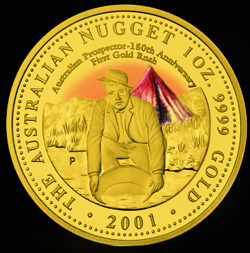 Australia – Top 2 World Gold Producer
Australia – Top 2 World Gold Producer
Not many people may realise that gold has been a dominant commodity in Australia for over a century and a half and Australia is the world top 2 producer of gold, with large quantities deriving predominantly from Western Australia and Queensland. Gold was found in Australia as early as the 1820s - the earliest recorded sighting of gold was in NSW in 1823. In 1851, following the first European settlement of Australia in 1788, the first of several gold rushes began, enticing people to Australia from many parts of the world. As a result, within 10 years Australia's population trebled - to more than 1 million.
In 2017 the World No 1 gold producer country remained China after pushing out South Africa from the top spot in 2007. South Africa had dominated word gold production for nearly 100 years. Australia is the number 2 gold producer. The 3rd and 4th world producers are Rusia and USA respectively; followed by Canada, Peru and South Africa in 5th, 6th and 7th positions.
Gold Discovery in Australia - Who’s Edward Hargraves?
" There is as much gold in the country I’m going to as there is in California, and Her Most Gracious Majesty, the Queen, God bless her, will appoint me one of her Gold Commissioners". - Edward Hargraves
Edward Hargraves was the man who would set off the first Australian gold rush. As self-appointed leader of a small group which travelled to California in 1850, Hargraves learned the craft of prospecting for gold with pans, cradles and excavation. More importantly he noticed similarities in the Californian terrain with that of his Australian home. Unsuccessful in California, he returned to Australia, determined to discover gold.
" One and all, however, derided me, and treated my views and opinions [as those] of a madman," he wrote.
But he went forth regardless.
After a long journey through the Blue Mountains, a rugged, sparsely-populated land occupied by sheep farms and small towns, Hargraves descended to the Bathurst plains, where he believed the gold field existed. After arriving in Gynong, Hargraves met John Lister, a man who had already found gold in the region, and followed him to where it was found.
" My recollection of it had not deceived me. The resemblance of its formations to that of California could not be doubted or mistaken. I felt myself surrounded by gold."
Hargraves put a party of Lister and brothers James and William Tom to work, teaching them mining methods he had learned in California. The small party excavated £13 worth of gold from the Summerhill Creek area.
Hargraves was willing to reveal the location of the field, but he cleverly ensured he would be rewarded regardless. After a lengthy persuasion, the Colonial Secretary sent a British geologist to examine the field, and subsequently dealt a £500 reward to Hargraves.
Before the geologist had made an official statement, Hargraves told many people of the finds. The Sydney Morning Herald published the story and word quickly spread. Hargraves was able to find enough gold to warrant the approval of the geologist, Samuel Sutchbury. Sutchbury "found granular gold within three hours of his arrival at the site, and within a few days he was downright optimistic about the size of the potential goldfield".
The government declared a gold discovery on May 22, 1851. Prospectors cancelled their trips to California. Clerks, labourers and servants failed to appear for work as thousands rushed west for the newly named "Ophir" gold field. The first Australian gold rush was on.
Just as he had prophesised, Hargraves was appointed Crown Commissioner of the Goldfields, reaping a further £10,000. Hargraves never shared his wealth with Lister or the Tom brothers, despite their protests (which were dragged into a lengthy court case, which Hargraves won). He also made a hasty effort to silence his original financier, ensuring no claims would be made on his wealth.
When Hargraves rushed to Sydney with the finds he went to the Colonial Secretary.
" If this is gold country," said the Colonial Secretary, "it comes on us like a clap of thunder, and we are scarcely prepared to credit it."
Mass Migration to Australia
Word that gold had been found spread quickly. People joined the rush from California, China and across the globe, arriving in droves at Australian ports. British migrants were the most numerous: as gold fever mounted, more Englishmen flocked to distant Australia than to Canada.
Australia, set up as a colony of peasant farmers and convict labourers, soon developed beyond the expectations of the empire. In what was viewed as a diabolical, topsy-turvy situation by the elite, peasants struck it rich and subverted the class systems of British society. For many it was a risk to leave home in the hope of striking it rich, but it was also the only chance they would ever have of breaking out of the under-class.
" Gold digging was a lottery. On the goldfields, education, upbringing and class meant nothing. A labourer was just as likely to strike it rich as his erstwhile master. Indeed, because of the necessity for continuous back-breaking work on the diggings, the labourer may have an advantage over his 'betters'. To some the situation seemed like an inversion of the natural order of society."
In 1852 Victoria was in the peak of the gold rush and an estimated 100,000 people arrived in Australia, many of whom were Chinese. The Chinese influence on the gold rush towns of Ballarat and Bendigo is still seen in some of the architecture.
Speaking of Thunderclaps…
Charters Towers, the town they call 'The World' was born to the sound of thunder and flashes of lightning. Hugh Mosman, George Clarke, James Fraser and a twelve-year-old aboriginal ‘horseboy’ Jupiter had been prospecting away to the south of what is now Charters Towers when their horses scattered during a fierce thunderstorm. It was while searching for the horses next morning that the first Towers gold was discovered. The discovery point was just near the modern day intersection of Mosman Street, Rainbow Road and Black Jack Road and was at the end of the year 1871 or the very beginning of 1872. The party returned to Ravenswood to register their find which they named Charters Towers. Charters - for W.S.E.M. Charters, the Gold Commissioner - the big man from the Cape (Charters was said to be about 6'6" tall and weighed some 20 stone). Towers - because of the conical shaped hills in the vicinity of the discovery.
A rush of ‘fortune seeking men’ quickly followed and a small settlement named Millchester formed on the watercourse at Gladstone Creek. By the end of 1872 the population grew from zero to 3,000 people! The alluvial men left the field early and moved on for the Palmer River discoveries but the hard rock miners remained, seeking the gold in the deep veins underground. A kilometre away, Charters Towers, rather than Millchester, soon became the main settlement.
On Top of the World
The goldfield reached its peak of gold production until 1899. During the period 1872-1899 the place changed from a rough settlement with bark and calico buildings to a thriving city of some 25,000 inhabitants. The city, by that time, had properly formed streets, some wonderful houses and many grand public buildings lining the two main streets. A plentiful supply of water for domestic and other purposes was pumped to the town from a Weir on the Burdekin River about 9 miles to the north. Underground electricity was also supplied to parts of the main town area.
Literally 100s of shafts were sunk during the hey-day of the field and the ore raised was processed through many large Treatment Batteries. Throughout the first 40 years over 130 individual mines produced an historic 200 tonnes of gold – virtually by pick and shovel. As the miners did not have the technology to ventilate their shafts, the mines seldom reached a vertical depth of more than 700 metres. Rather than suffocate, the workmen ceased operations – the gold never ran out! And although production came to a halt in 1917, to this day the Charters Towers goldfield remains Australia’s fifth-largest gold producer and the richest gold ore grades of all the major gold fields.
All religions were strongly represented on the field and in 1890 the miners could quench their thirst in no less than 65 hotels registered on the field. Sports, music and the arts all had fantastic followings. It is said that everything you might desire could be had in the Towers. There was no reason to travel elsewhere for anything. This is why the town became known affectionately as ‘The World’.
Some References
Geoff Hocking, To the diggings!: a celebration of the 150th anniversary of the discovery of gold in Australia, Lothian Books, 2000.
Douglas, Fetherling, The gold crusades: a social history of goldrushes, 1849-1929, University of Toronto Press, 1997.
Edward Hargraves, Australia and its goldfields, H. Ingram, 1855.
Marion Place, Gold Down Under, The Story of the Australian Goldrush, Crowell-Collier Press, 1969.
Michael Evans, ‘Gold Fever: Life on the Diggings’, Gold 150, Celebrating 150 Years of Australian Gold-Rush History
John Sherer, The Gold-finder of Australia: how he went, how he fared, how he made his fortune, Clarke, Beeton, 1853

